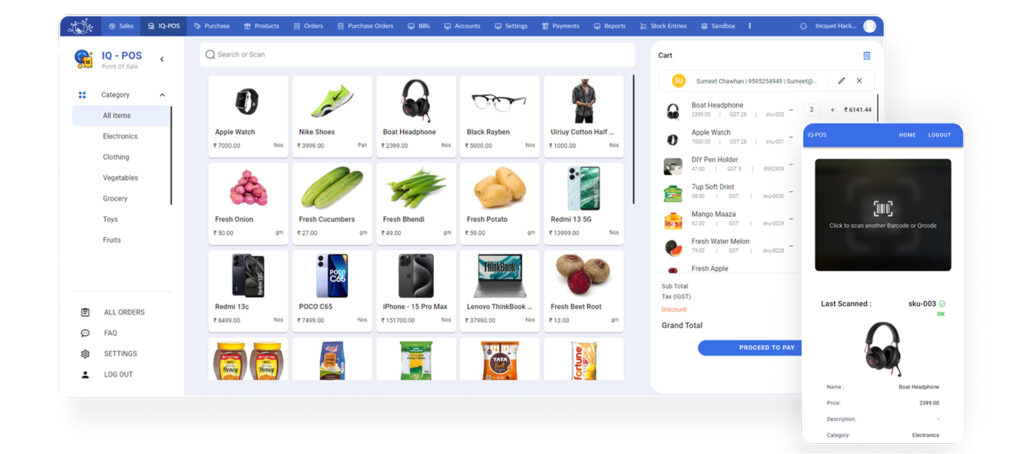Discover why 80% of retail operations struggle with daily operations. Learn the hidden costs of broken systems. See how unified platforms stop operational chaos.
Why Retail
Ops Struggle?
Digital Transformation of Retail Operations
Table of Content
- The Real Problem Behind Retail Chaos
- The Three Hidden Problems Killing Store Operations
- Why Operations Excellence Matters More in 2025
- What High-Performance Retail Operations Look Like
- The Choice Every Retailer Must Make
- Ready to Transform Your Operations?
- Watch our Retail Operations Transformation webinar
- Take the Next Step
Why Retail Ops Struggle?
Digital Transformation of Retail Operations
by Ajinkya Sawant | 18 September,2025 | 4 Min Read
Every morning, thousands of retail managers face the same problem.
They arrive at their stores ready to drive sales and serve customers. But within hours, they’re drowning in chaos. They juggle disconnected systems, chase manual updates, and fight fires that shouldn’t exist.
At Incquet Solutions, we’ve seen this pattern across retail changes over several years. The problem isn’t competition or market conditions. The problem is that retail systems work against success, not for it.
The Real Problem Behind Retail Chaos
The Morning Routine:
- Check yesterday’s sales on the POS system
- Walk to the back office, open Excel for inventory
- Review WhatsApp messages for vendor updates
- Log into accounting software for payments
- Check staff schedules on another app
By 10 AM, managers have used five different systems. They just want to understand their store status.
The Afternoon Crisis:
- Customer asks about product availability across locations
- Staff spends 10+ minutes calling other stores
- Billing queues build up during the search
- Popular items run out of stock (found by accident)
- End-of-day reconciliation takes 2+ hours because systems don’t talk
This isn’t just inefficiency. This is system chaos.
1. The Information Gap
Modern retail operates fast. Most retail information systems operate slow.
Stock shortages are found after customers ask. Payment delays surface only during month-end. Billing errors are found days later. Retailers are always reactive instead of proactive.
Hidden Costs:
- Lost sales opportunities
- Frustrated customers
- Reactive management that should drive growth
2. The Switching Tax
Every system switch costs teams 3-5 minutes. With 50+ daily switches across multiple staff, productivity loss adds up fast.
Beyond time loss, constant switching does more damage. It increases errors. It reduces customer attention. It burns out staff.
Hidden Costs:
- 15-20% productivity drop across store operations
- Higher error rates
- Increased staff turnover from system stress
3. The False Integration
Many retailers think their systems work together. They use manual exports, email attachments, and copy-paste work.
This isn’t integration. It’s digital paperwork that doubles workload while multiplying errors and killing real-time visibility.
Hidden Costs:
- Doubled workload (manual + digital)
- More error opportunities at every step
- Zero real-time intelligence for decisions
Retail margins keep shrinking. Customer expectations keep rising. Good staff is harder to find.
In this environment, operational friction isn’t just annoying. It’s a threat to retail survival.
The retailers winning in 2025 aren’t selling better products. They’re running better operations:
Faster, more accurate billing
Real-time inventory visibility
Seamless customer experiences
Data-driven decisions
They’ve eliminated the chaos tax killing their competitors.
What High-Performance Retail Operations Look Like
Through hundreds of retail changes, we’ve found three key traits. These traits separate winners from strugglers:
1. Single Source of Truth
All data flows through one connected system. Billing, inventory, customers, reports. No manual exports. No imports. No reconciliation nightmares.
2. Real-Time Intelligence
When sales happen, inventory updates instantly. When stock drops, alerts trigger immediately. When trends shift, dashboards reflect changes now.
3. Mobile-First Design
Store operations happen on the sales floor, not at desks. High-performance systems put power in managers’ pockets, not chained to computers.
The technology exists. The platforms work. The question isn’t whether retail operations can be fixed. It’s whether retailers will embrace change.
The Choice Every Retailer Must Make
Every retail business faces the same decision:
Option 1: Accept Chaos as “Normal”
Keep fighting broken systems daily
Hire more staff to manage complexity
Hope things will improve over time
Option 2: Transform Your Foundation
Invest in unified systems designed for retail
Eliminate daily friction bleeding efficiency
Build operations that grow with your business
Retailers choosing Option 2 aren’t just surviving. They’re building advantages while competitors struggle with basics.
Ready to Transform Your Operations?
Retail operations don’t need more software. They need systems that actually work.
- The true cost of broken retail operations
- How unified platforms eliminate the chaos tax killing profitability
- Live demo of seamless retail automation across real store scenario
- Interactive Q&A for your specific challenges
Watch our Retail Operations Transformation webinar
It’s a straategic guide to building operations. Operations that drive growth instead of eating resources.
Take the Next Step
Change starts with understanding where current systems cost your business. They cost time, money, and advantage.
What’s your biggest operational challenge? Our team reads and responds to every inquiry with specific, actionable guidance.
At Incquet Solutions, we believe retail success shouldn’t be limited by operational chaos. Let’s build systems that work as hard as you do.
IQShopfloor: Modern Retail, Made Simple!
One platform to manage billing, inventory, and checkouts.

Related Articles
How to Build Powerful Business App with Zoho Creator
Zoho Creator 101 is an educational series from Incquet Solutions to help people build a powerful business app for any size of businesses in easiest ways possible.



